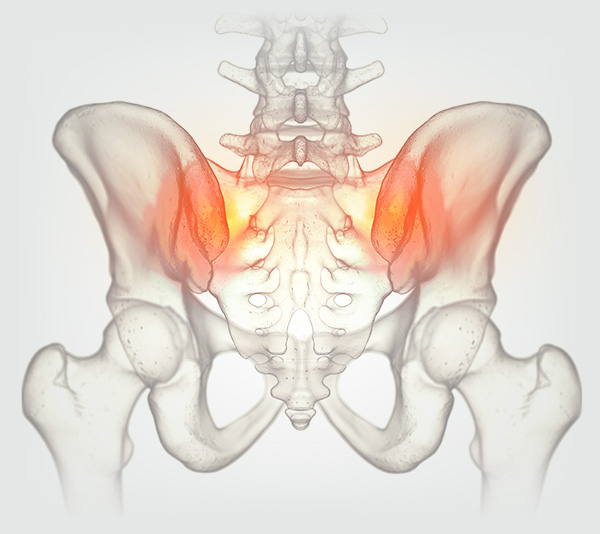About Sacroiliac (SI) Joint Instability
The sacroiliac joints (SI) are the foundation of the spine, located at the junctions of the sacrum and ilium on each side.
These complex joints, composed of systems of ligaments and multiplanar joint surfaces, transmit the forces exerted through the spine from the upper body to the legs. The SI joint is designed to absorb shock forces and is naturally constrained to only limited movement. Instability in the SI joint is a major pain generator in some patients.
Although there have been many advances in surgical techniques to address instability problems in the lumbar spine, instability in the SI joint has remained relatively unaddressed, with most patients running out of options once conservative treatments have failed to offer continued relief from painful SI symptoms.

Causes of SI Joint Instability and Pain
- Prior injury or accident
- Postpartum Pelvic Girdle Pain
- Ligamentous loosening due to Pregnancy
- Arthritis
- Osteoarthritis
- Low back instability or prior low back surgery
Common Symptoms of SI Joint Pain
- Low back pain
- Pelvis/buttock pain
- Lower extremity pain
- Hip/groin pain
- Problems sitting, sleeping, or walking
Diagnosis of SI Joint Instability and Dysfunction
Step 1: History and Complaints of Pain
Step 2: Sacroiliac Joint Examination
- Point to Pain
- Palpate
Step 3: Sacroiliac Joint Dysfunction Five Provocative Tests
The Non-Invasive Process of Identifying Sacroiliac Joint Dysfunction (Mac/LCD guidelines require 3 of 5 positive results)
 Distraction
Distraction
The patient will lie on their back, with support for their lower back to help maintain the natural curve of the lumbar spine. The clinician places their hands on each side of the pelvis, arms crossed, and applies a slow and steady posterior force by leaning down toward the patient.
 Thigh Thrust
Thigh Thrust
The patient will lie on their back with the affected hip flexed to 90 degrees with the knee bent. The clinician then applies a steadily increasing force through the axis of the femur.
 FABER
FABER
While the patient is lying on their back, the clinician crosses the affected-side foot to the opposite side. The pelvis is stabilized on the opposite side by the hand of the clinician. The clinician then applies a gentle, yet steadily increasing, downward pressure to the knee to exaggerate the motion of hip flexion, abduction, and external rotation.
 Compression
Compression
The patient will be placed on their side with the affected side up and facing away from the examiner. The knees should be bent with a pillow between the knees. The clinician applies steady downward pressure to the pelvis.
 Gaenslen’s
Gaenslen’s
The test is performed with the patient lying on their back with the affected side leg near the edge of the exam table. For safety, the patient’s shoulders should be positioned towards the middle of the table. The patient will then pull and hold the non-affected leg into full flexion at the hip and at the knee. The clinician will stabilize the leg with their hand placed over the patient’s hand and apply gentle downward pressure.
Step 4: Diagnostic Injections
- MAC / LCD Dependent – Typically two injections that give 75% relief
Treatment Cycle and Options
When it is suspected that some or all of a patient’s symptoms could be attributed to SI joint instability, it is recommended to begin with conservative treatment options. Conservative treatment may include physical therapy, chiropractic manipulation, patient specific exercise programs, or bracing.
Pain management evaluation and intervention may be the next step, including pain medications or therapeutic injections that may provide some patients temporary relief, but often only work short term. Radio-frequency ablation (RFA) has also been used with some success, but similar to injections, may only provide temporary relief.
SI joint fusion should only be considered after non-surgical interventions have failed to provide a patient with an enduring solution to their pain. Fusing the SI joint, thereby eliminating pain generating instability, can provide enduring pain relief.
SI Joint Fusion using the CornerLoc™ SI Joint Fusion System may be the right solution for your patient. Contact us today to request more information.
